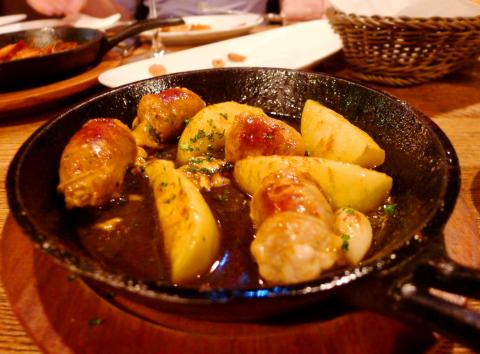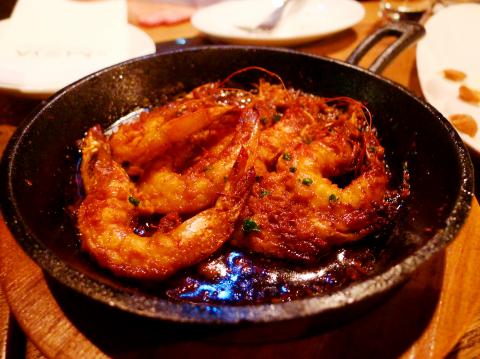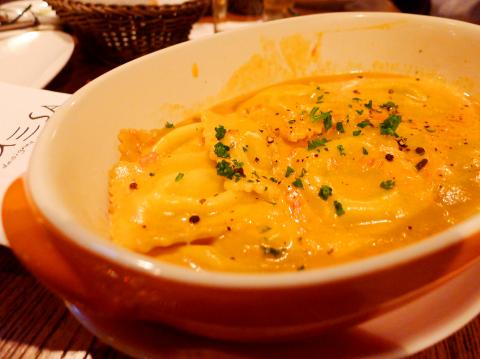There are plenty of restaurants specializing in tapas in Taipei, but La Mesa leaves such an impression that you walk out already planning your next visit. Since opening less than a year ago, it has made a statement about small plates: Big flavors come in small portions.
The first time I walked into La Mesa, the first of about nine times since, a grinning Westerner greeted me from behind a bar that I immediately wanted to sit at. I later learned that he and his Spanish partner, Chef Paco, run the two-story restaurant together. The bar takes up much of the first floor and behind it, a brick wall lines one side of the restaurant, lending it a New York City vibe. For those who like the open kitchen concept, there are a few tables on the first floor. Next to a very modern and slightly terrifying metal staircase, there is also a full dining room nicely equipped to handle large parties. The lighting is dim and the volume is loud, but this is because the restaurant is packed most nights of the week.
Tapas — or Spanish snacks — are served with sophistication and one could easily make a meal out of picking at a few of them. The raw beef carpaccio (NT$320) deserves an honorable mention. The marinated mix (NT$320) is a good combination of foods worth trying — grilled bell peppers, anchovies, artichoke hearts, olives, and sardines. But don’t get carried away with these cold tapas because the menu only gets better.

Photo: Olivia Wycech
Hot tapas. The chorizo in cider and garlic (NT$220) might be the best my palate has had the pleasure of tasting. Chef Paco makes the sausages from scratch and they are accompanied by sweet apples that balance out the kick from the chorizo, which is not overly spicy anyway. The six shrimp (NT$230) are cooked with garlic and come served on a hot skillet. The meatballs (NT$230) are nothing fancy, but La Mesa dresses them up with a delicious tomato emulsion that goes well with bread.
The deep-fried calamari (NT$200) arrived with a “spicy” aioli (it’s more tangy than spicy). The only problem is that they don’t give you anywhere near enough of it. I haven’t been lucky enough to dine on a day where they’ve had fresh mussels (NT$320), but this dish comes infused in a white wine and cream sauce that has generated buzz among my friends.
Main entrees include ravioli (NT$390), which is popular among vegetarians. I found that the pumpkin and ricotta ravioli carried more flavor than the spinach and ricotta. Both are served with a rich cream sauce that seems to better enhance the presence of pumpkin.

Photo: Olivia Wycech
The melt-in-your-mouth duck confit (NT$390) has my rave review. While the duck is quite salty, the onions are caramelized with sweet undertones of orange. It all blends together seamlessly.
You could hardly say you had Spanish food without trying paella, which should definitely be ordered for the table whether you are a party of two or eight. The house paella (NT$780) is my favorite and looks as beautiful as it tastes. It’s a traditional saffron-saturated rice medley of chicken, chorizo, squid, giant shrimp and mussels.
The Spanish like to drink sangria. Start by ordering a jug (NT$950) because just one glass (NT$250) of the best damn sangria in Taipei simply isn’t enough. La Mesa has adapted Spain’s tradition of social snacking, and since they are open pretty late most days, drinking and eating can go on all night.

Photo: Olivia Wycech

Photo: Olivia Wycech

The canonical shot of an East Asian city is a night skyline studded with towering apartment and office buildings, bright with neon and plastic signage, a landscape of energy and modernity. Another classic image is the same city seen from above, in which identical apartment towers march across the city, spilling out over nearby geography, like stylized soldiers colonizing new territory in a board game. Densely populated dynamic conurbations of money, technological innovation and convenience, it is hard to see the cities of East Asia as what they truly are: necropolises. Why is this? The East Asian development model, with

June 16 to June 22 The following flyer appeared on the streets of Hsinchu on June 12, 1895: “Taipei has already fallen to the Japanese barbarians, who have brought great misery to our land and people. We heard that the Japanese occupiers will tax our gardens, our houses, our bodies, and even our chickens, dogs, cows and pigs. They wear their hair wild, carve their teeth, tattoo their foreheads, wear strange clothes and speak a strange language. How can we be ruled by such people?” Posted by civilian militia leader Wu Tang-hsing (吳湯興), it was a call to arms to retake

This is a deeply unsettling period in Taiwan. Uncertainties are everywhere while everyone waits for a small army of other shoes to drop on nearly every front. During challenging times, interesting political changes can happen, yet all three major political parties are beset with scandals, strife and self-inflicted wounds. As the ruling party, the Democratic Progressive Party (DPP) is held accountable for not only the challenges to the party, but also the nation. Taiwan is geopolitically and economically under threat. Domestically, the administration is under siege by the opposition-controlled legislature and growing discontent with what opponents characterize as arrogant, autocratic

When Lisa, 20, laces into her ultra-high heels for her shift at a strip club in Ukraine’s Kharkiv, she knows that aside from dancing, she will have to comfort traumatized soldiers. Since Russia’s 2022 invasion, exhausted troops are the main clientele of the Flash Dancers club in the center of the northeastern city, just 20 kilometers from Russian forces. For some customers, it provides an “escape” from the war, said Valerya Zavatska — a 25-year-old law graduate who runs the club with her mother, an ex-dancer. But many are not there just for the show. They “want to talk about what hurts,” she